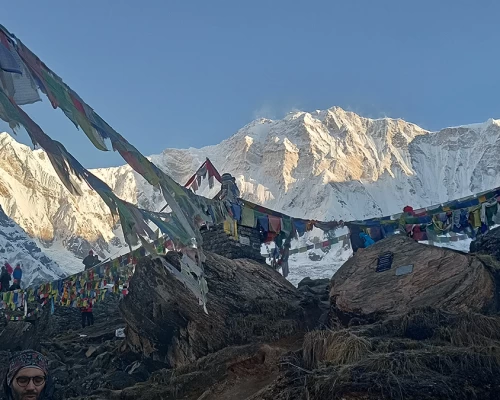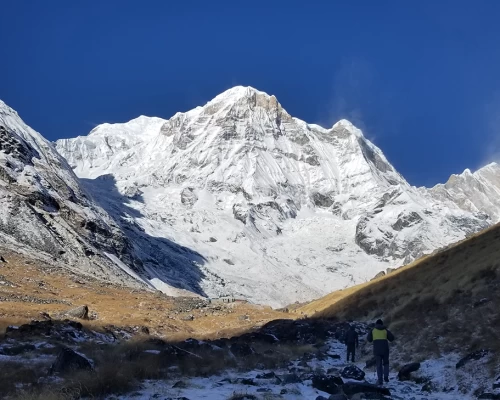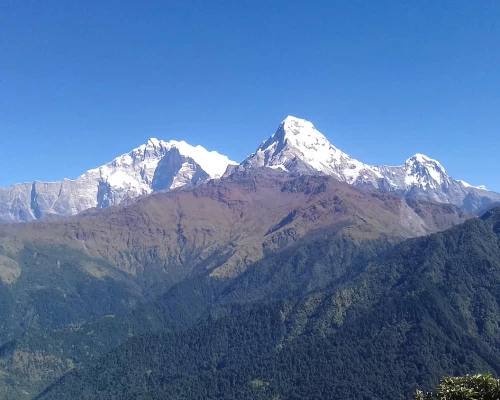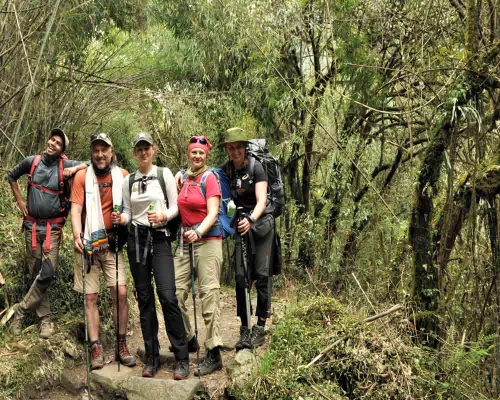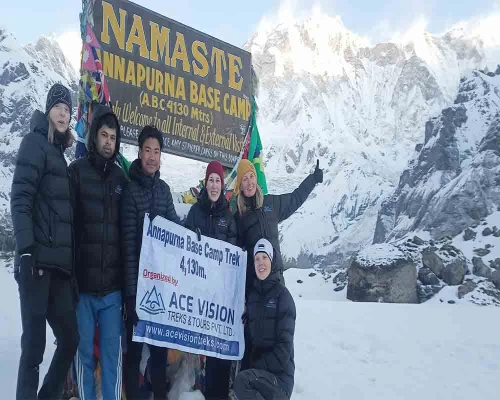Annapurna Base Camp Trek is one of the most popular teahouse treks in Nepal, which takes you to the foot of the majestic Mount Annapurna. With an altitude of 8,091 meters (26,545 feet), Annapurna is the tenth-highest mountain in the world.
Though, Annapurna is among the most dangerous of the eight-thousanders summits, the trek to base camp is one of the most popular and widely trekked ones.
ABC trek is considered a moderate trek suitable for experienced as well as newbies. The highest elevation in the ABC trek is base camp at an altitude of 4,130 m (13,546 ft).
The trek to Annapurna Base Camp offers breathtaking views of the Annapurna range, Macchapuchhre, Gangapurna, and Hiunchuli.
You traversed through Annapurna Conservation Area rich in flora and fauna. You trek through lush green forests with diverse landscapes and get to see the sunrise from Poon Hill and the natural hot springs at Jhinu Danda.
The best season to trek ABC is autumn and spring season. Since the ABC trek is popular, there will be no problem with accommodation. Hotels and teahouses are present in every stage.
This journey will take you on a tour to experience the natural splendor of a thick rhododendron forest, Himalayan massifs, witnessing rich biodiversity, remote rural villages, terraced rice terraces, high altitude panoramas, and the beautiful forest region of the Annapurna.
It is an experience unlike any other and is frequently ranked among the top 10 greatest treks in the world. So, come along and experience this life journey.
Annapurna Base Camp Trek route
Annapurna Trekking starts with a trek from Hille passing through Ulleri, Ghorepani, Tadapani, Sinuwa, and Deurali to reach the base camp.
Getting mesmerized by the views you start the descent as you pass through Bamboo, Jhinu Danda, Siwi, and then finally arrive at Pokhara.
At 4130 m/13,546 ft, Annapurna Base Camp elevation of the trek. There is no need for acclimatization days in between because the Annapurna Base Camp trip typically involves a daily hike of 4–6 hours.
The elevation difference between Pokhara and ABC is 3,310 m/ 10,860 ft with around 500 m/1,640 ft of modest elevation gain.
Best places to visit in the Annapurna Region
One such community along the path is Ghandruk. The pretty houses with slate roofs next to the paddy field give a very rural quaint perspective. You are also permitted to wear traditional Gurung attire. It's the ideal location to unwind and recharge for the journey ahead.
Likewise, the Annapurna Conservation Project a repository of Himalayan wildlife is passed. It commands an area of 7629 sq. km. protecting rare and endangered wildlife. You will see many wildlife such as the Himalayan musk deer, red panda, Tibetan antelope, etc.
Annapurna Sanctuary is also passed along the trek which is a revered glacial basin at a height of over 4,000 meters encircled by the peaks Annapurna South, Annapurna I, and others. The clearest views of the Milky Way are available from here.
Besides, many animistic gods and gods of Hindu and Buddhist origin are believed to reside. The inhabitants believe that gods live beneath the mountains, hence any form of killing is forbidden here.
Besides, Poon Hill is a great vantage point providing stunning morning views of Macchapuchhre, Hiunchuli, Nilgiri, and many others.
Moreover, Pokhara itself is an absolute delight. There are several entertainment options in Pokhara. It's wonderful to merely take in the scenery surrounding Pokhara. Phewa Lake, where you can kayak and take in the reflection of the western Himalayas.
Annapurna Region's Culture and People
Various ethnic groups, particularly the Gurung, are found on the Annapurna Trekking Trail. Gurungs have fought in Gorkha Battalions and are renowned for their bravery. There are lots of opportunities for conversation and getting to know one another on the tour.
Additionally, visitors can dress traditionally and blend in with the Gurung population. As you ascend the ABC Trek routes, you come into contact with a variety of ethnic communities, therefore you will be welcomed by various ethnic groups.
The inhabitants of the area include other mongoloid and Brahmin and Chhetri. Mongoloid Himalayan people live at higher elevations, while Brahmans and Chhetri live at lower altitudes.
Annapurna Base Camp Trek for Beginners
Beginners who are trekking in the Nepal Himalayas for the first time consider the Annapurna Base Camp via Poonhill. The Trek is open to anyone with moderate fitness. Anyone in good health can undertake it even children as small as 10 years old.
The ABC Trek can completed in six days however, for a beginner it is highly unadvised as taking the longer route allows your body to get used to the changed elevation.
Hiking through Ghandruk and climbing Poon Hill is highly advised as it allows for acclimatization and a better trekking experience with great views.


